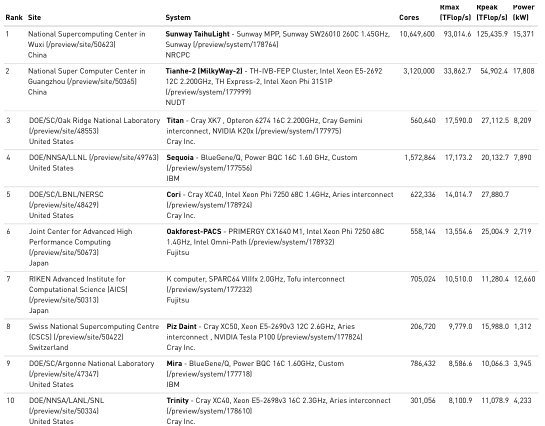 In this podcast, the Radio Free HPC team reviews the latest TOP500 list of the world’s fastest supercomputers.
In this podcast, the Radio Free HPC team reviews the latest TOP500 list of the world’s fastest supercomputers.
The 48th edition of the TOP500 list saw China and United States pacing each other for supercomputing supremacy. Both nations now claim 171 systems apiece in the latest rankings, accounting for two-thirds of the list. However, China has maintained its dominance at the top of the list with the same number 1 and 2 systems from six months ago: Sunway TaihuLight, at 93 petaflops, and Tianhe-2, at 34 petaflops. This latest edition of the TOP500 was announced Monday, November 14, at the SC16 conference in Salt Lake City, Utah.
After US and China, Germany claims the most systems with 32, followed by Japan with 27, France with 20, and the UK with 17. A year ago the US was the clear leader with 200 systems, while China had 108, Japan had 37, Germany had 33, and both France and the UK had 18.
In addition to matching each other in system count in the latest rankings, China and the US are running neck and neck in aggregate Linpack performance. The US holds the narrowest of leads, with 33.9 percent of the total; China is second with 33.3 percent. The total performance of all 500 computers on the list is now 672 petaflops, a 60 percent increase from a year ago.
The top of the list did receive a mild shakeup with two new systems in the top ten. The Cori supercomputer, a Cray XC40 system installed at Berkeley Lab’s National Energy Research Scientific Computing Center (NERSC), slipped into the number 5 slot with a Linpack rating of 14.0 petaflops. Right behind it at number 6 is the new Oakforest-PACS supercomputer, a Fujitsu PRIMERGY CX1640 M1 cluster, which recorded a Linpack mark of 13.6 petaflops. Oakforest-PACS is up and running at Japan’s Joint Center for Advanced High Performance Computing (JCAHPC). Both machines owe their computing prowess to the Intel “Knights Landing” Xeon Phi 7250, a 68-core processor that delivers 3 peak teraflops of performance. The addition of Cori and Oakforest-PACS pushed every system below them a couple of notches down, with the exception of Piz Daint, a Cray supercomputer installed at the Swiss National Supercomputing Centre (CSCS). It maintained its spot at number 8 as a result of a massive 3.5 petaflop upgrade, courtesy of newly installed NVIDIA P100 Tesla GPUs.
 Piz Daint also has the honor of being the second most energy-efficient supercomputer in the TOP500, with a rating of 7.45 gigaflops/watt. It is topped by NVIDIA’s in-house DGX Saturn V system, the only other system on the list equipped with the new P100 GPUs. It is a 3.3-petaflop cluster of DGX-1 servers that delivers 8.18 gigaflops/watt. To offer some perspective here, the nominal goal for the first exascale systems is 50 gigaflops/watt.
Piz Daint also has the honor of being the second most energy-efficient supercomputer in the TOP500, with a rating of 7.45 gigaflops/watt. It is topped by NVIDIA’s in-house DGX Saturn V system, the only other system on the list equipped with the new P100 GPUs. It is a 3.3-petaflop cluster of DGX-1 servers that delivers 8.18 gigaflops/watt. To offer some perspective here, the nominal goal for the first exascale systems is 50 gigaflops/watt.
 Download the MP3 * Subscribe on iTunes * RSS Feed
Download the MP3 * Subscribe on iTunes * RSS Feed
See our complete coverage of SC16, which takes place Nov. 13-18 in Salt Lake City.



